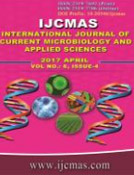


 National Academy of Agricultural Sciences (NAAS)
National Academy of Agricultural Sciences (NAAS)

|
PRINT ISSN : 2319-7692
Online ISSN : 2319-7706 Issues : 12 per year Publisher : Excellent Publishers Email : editorijcmas@gmail.com / submit@ijcmas.com Editor-in-chief: Dr.M.Prakash Index Copernicus ICV 2018: 95.39 NAAS RATING 2020: 5.38 |
Enterobacteriaceae are inhabitants of the intestinal flora. Emergence of Carbapenem resistant Enterobacteriaceae (CRE) is a serious threat to public health. They rapidly acquire and transfer drug resistance genes through plasmids and transposons and spread to community via faeco-oral route. Hence the present study was done to know the magnitude of Carbapenem resistant Enterobacteriaceae in our hospital. This study was conducted in the department of Microbiology, SIMS and RH, Tumkuru during a period from May 2016 to October 2016. A total of 106 Enterobacteriaceae isolates were obtained by various clinical samples and from different department of the hospital. These isolates were screened for carbapenem resistance by disk diffusion method according to CLSI guidelines. Prevalence of CRE in our hospital is 44. 33%. Meropenem resistance (31. 13%) was higher than Imipenem resistance among CRE isolates. In this study, CRE is more common in male (50. 90%) patients. Majority of the sample is urine (55. 26%) and Maximum number of cases was from (51. 61%) OBG department. Most common species isolated was (63. 04%) Escherichia coli. Carbapenem resistant Enterobacteriaceae are more prevalent in our hospital. Hence use of carbapenem should be restricted to treat severe infections.
 |
 |
 |
 |
 |